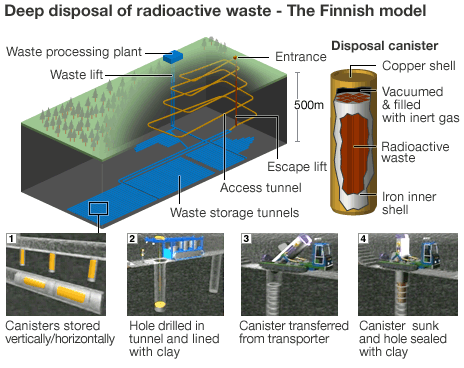This is the third in a four part series on nuclear waste which is running on BraveNewClimate.com over a four-day period, authored by Geoff Russell. Go here for Part 1 and Part 2.
Case studies in waste disposal
Finland’s nuclear waste repository
For many, I suspect the most compelling evidence for thinking that nuclear waste is a tough problem is news stories about billions of dollars being spent or foreshadowed to build repositories. Let’s consider an expensive example.
Finland’s nuclear industry is often held up as evidence of how costly nuclear power is because they have a reactor project that is way over time and over budget … Olkiluoto 3. The Finns are so devastated by the problems that they’ve ordered another one … Olkiluoto 4. Possibly because, despite the problems and cost-overruns of this “first of its kind” reactor, it’s electricity will still be some four times cheaper than German solar electricity.
 But our main interest is in Finland’s planned state of the art nuclear waste repository. The rock that the nuclear waste will replace hasn’t moved for 2 billion years. Drilling 400 meters into igneous rock isn’t cheap, but this isn’t a complex intractable problem. It’s just a hole in some rock. It will cost 3 billion Euros over the next 60 years. They’ve already put aside 2 billion Euros for this expense out of profits made selling their nuclear electricity. Reactors generate such huge amounts of electricity that waste disposal costs per megawatt hour are a very tiny overhead.
But our main interest is in Finland’s planned state of the art nuclear waste repository. The rock that the nuclear waste will replace hasn’t moved for 2 billion years. Drilling 400 meters into igneous rock isn’t cheap, but this isn’t a complex intractable problem. It’s just a hole in some rock. It will cost 3 billion Euros over the next 60 years. They’ve already put aside 2 billion Euros for this expense out of profits made selling their nuclear electricity. Reactors generate such huge amounts of electricity that waste disposal costs per megawatt hour are a very tiny overhead.
If you still think a 3 billion Euro repository is expensive, then compare it to the 100 billion Euros Germany is paying in feed in tariffs over the next 20 years for just 19 terawatt hours of electricity from solar panels installed before the end of 2011.
What about the bad old days of nuclear waste disposal?
Prior to 1972 nuclear waste was just dumped at sea.
What were they thinking?
That’s just it, they were thinking.
Filed under: Impacts, Nuclear | 2 Comments »






.png)





